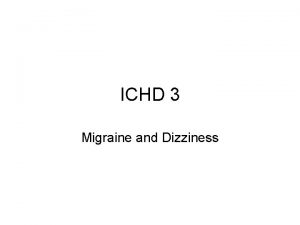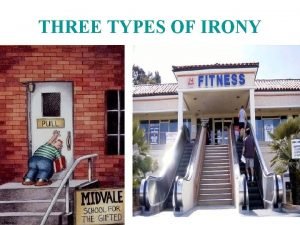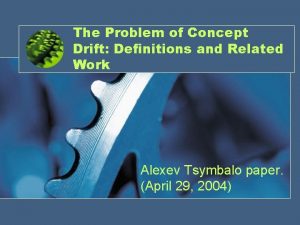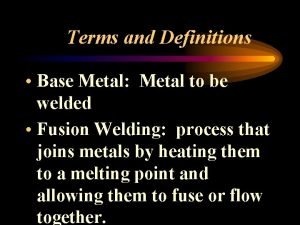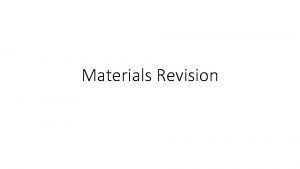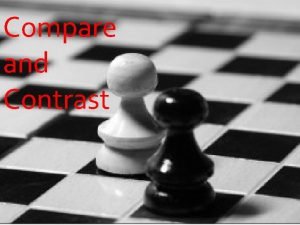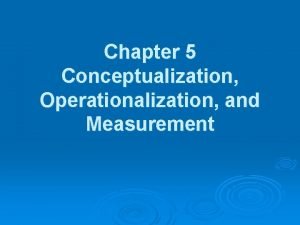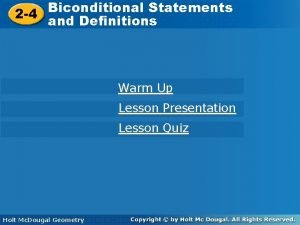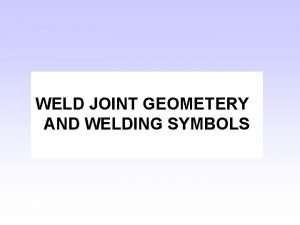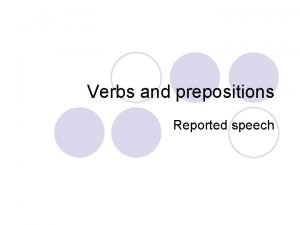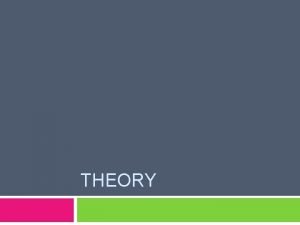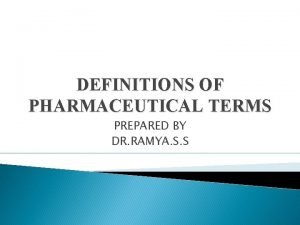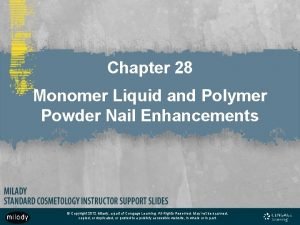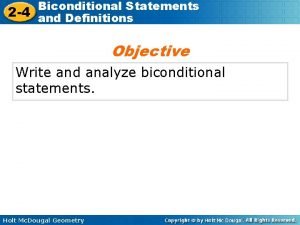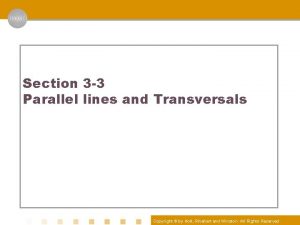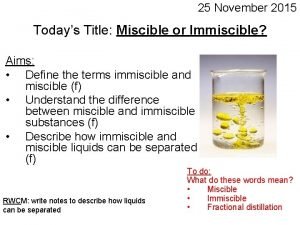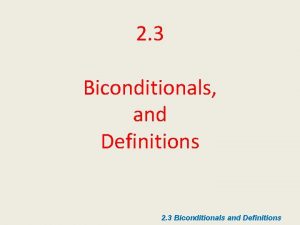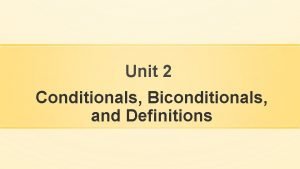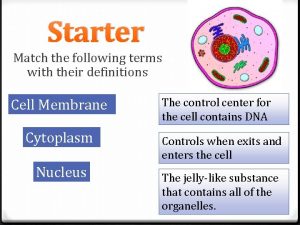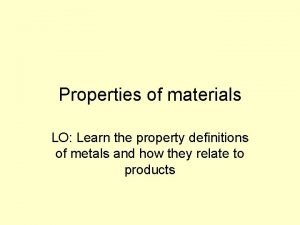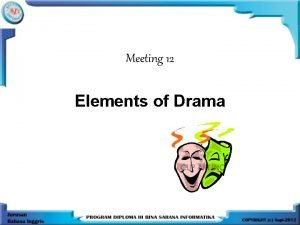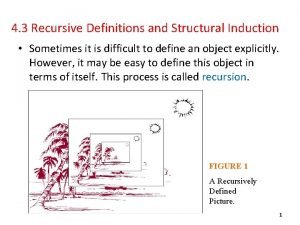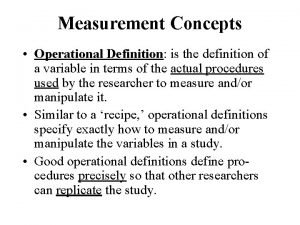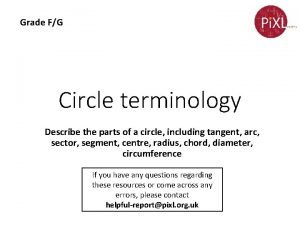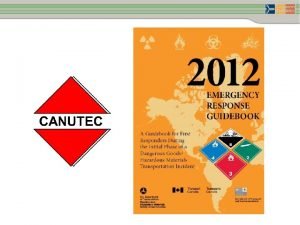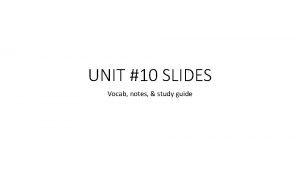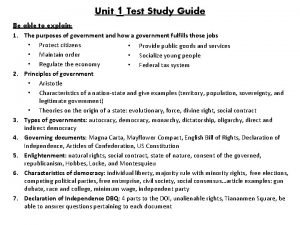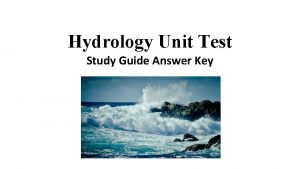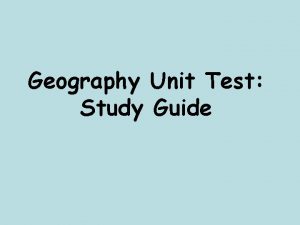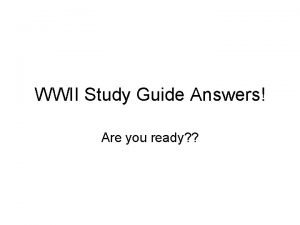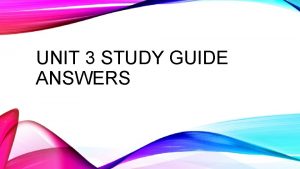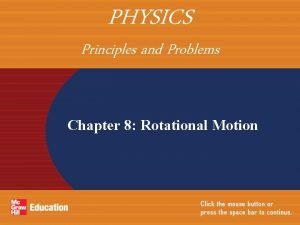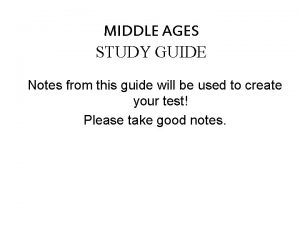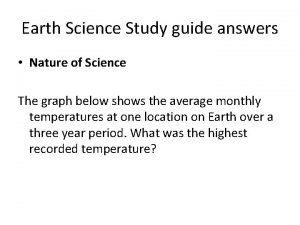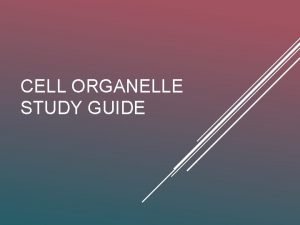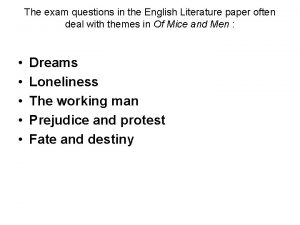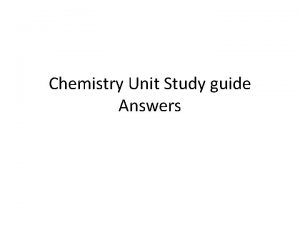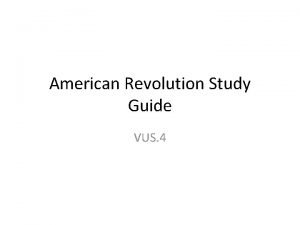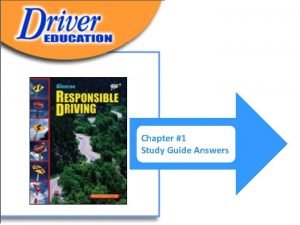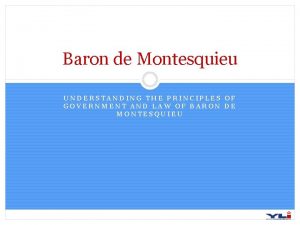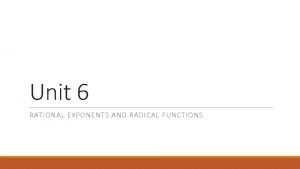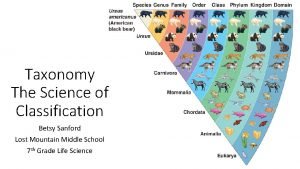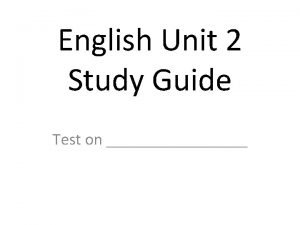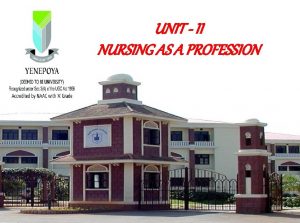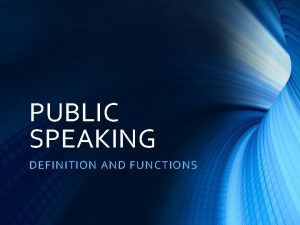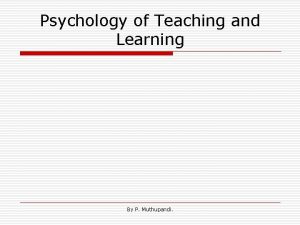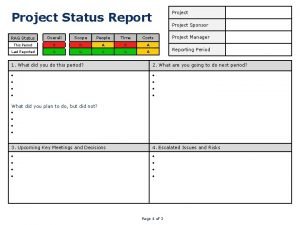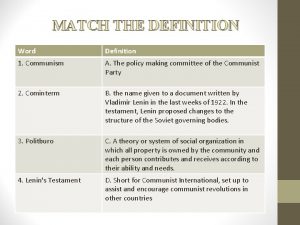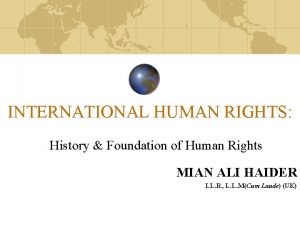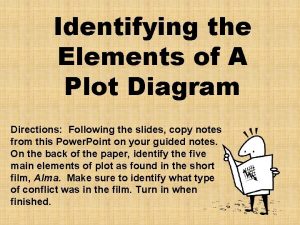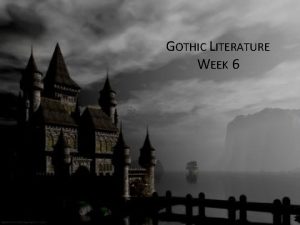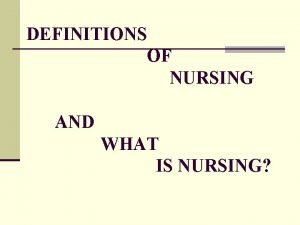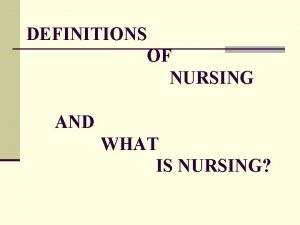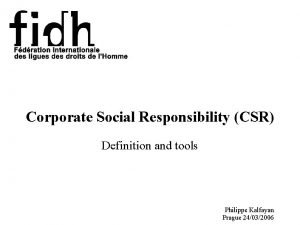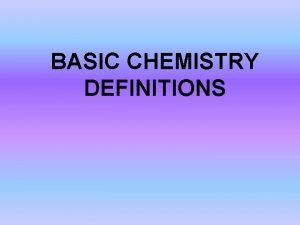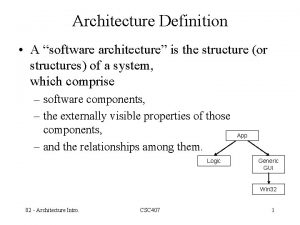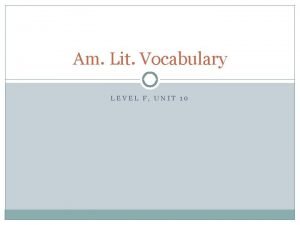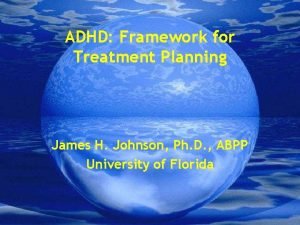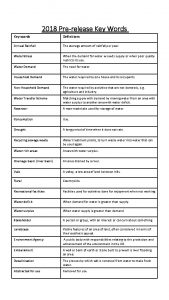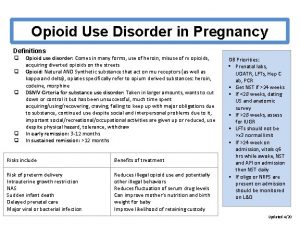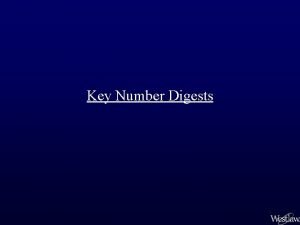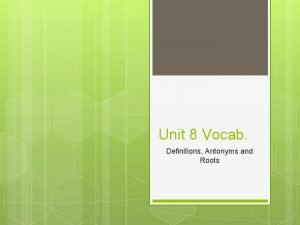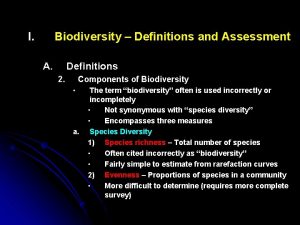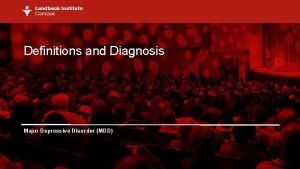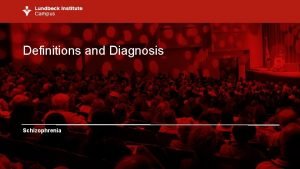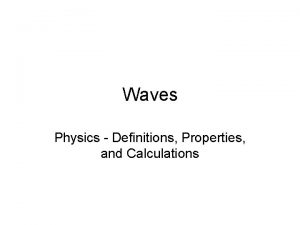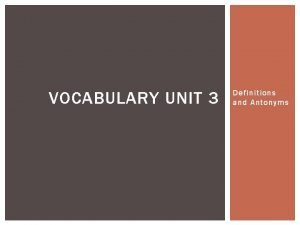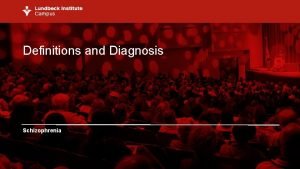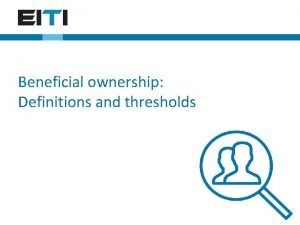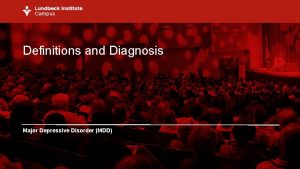ICHD 3 Guide to use and key definitions































































































- Slides: 95

ICHD 3 – Guide to use and key definitions AHS UCNS Board Review Morris Levin, MD, FAHS Chief, Division of Headache Medicine, UCSF ICHD 3

Disclosures for Dr. Morris Levin Consultant: Supernus, Upsher-Smith, Lilly, Amgen, Allergan, Alder, Teva Royalties: Oxford University Press, Anadem Publishing, Wiley Blackwell, Castle Connolly Publishing, UCSF Office of Innovation

Learning Objectives: 1. Describe the structure and format of the ICHD III 2. List major diagnostic criteria for the common primary headache disorders 3. Discuss significant challenges and controversies in primary and secondary headache diagnosis

Why do we need a headache classification system? • • • It helps with research into mechanisms & treatment Essential for understanding headache epidemiology Reimbursement A tool for Diagnosis Patients want a dx “Dr. Levin is not in right now. When you hear the beep please leave your name, number, and ICHD 3 diagnosis. ”

What is the Ideal HA classification? • Hierarchical – groups can be nested within one another, creating a hierarchy – splitters and lumpers can be happy • Each entity has a unique classification • Intuitive • Easy to use • Practical

Problems in Headache Diagnosis and Classification No lab markers in primary headaches Entirely dependent in primary headaches upon history Variability in definitions for syndromes Poor demarcation between diagnoses Research is difficult Episodic disorders symptoms and signs change Expert opinion They disagree 3 rd HA Classification Committee Jes Olesen, Denmark (Chairman) Lars Bendtsen, Denmark David Dodick, USA Anne Ducros, France Stefan Evers, Germany Michael First, USA Peter J Goadsby, UK Andrew Hershey, USA Zaza Katsarava, Germany Morris Levin, USA Julio Pascual, Spain Michael B Russell, Norway Todd Schwedt, USA Timothy J Steiner, UK(Secretary) Cristina Tassorelli, Italy Gisela M Terwindt, The Netherlands Maurice Vincent, Brazil Shuu-Jiun Wang, Taiwan

History • International classification of headache disorder , 1 st edition (ICHD-1) in 1988 • ICHD-2 in 2004 • ICHD-3 beta in 2013 • ICHD-3 in 2018* *Based on 4 years of input including field testing and research aimed at increasing precision and accuracy ICHD 3

Painful structures in the head (neck) • • • • Dural veins and arteries Intracran arteries V, VII, IX, X, C 1 -3 Periosteum Scalp muscles Scalp vessels Sinuses Eyes Ears Teeth, TMJ Carotids, vertebrals C-spine periost Cerv musc

Painful structures in the head (neck) Not painful • • Parenchyma Pia, arachnoid Skull Ventricles

ICHD III – Basic Organization Part 1: Primary headaches Part 2: Secondary headaches Part 3: Cranial Neuralgias, etc. The Appendix ICHD 3

ICHD III The Appendix: 1. Suggested criteria for possible new entities 2. Alternative diagnostic criteria for certain categories (pending evidence) 3. Some previously accepted disorders which have not been supported by evidence

ICHD III Part 1: Primary headaches (no other causative disorder) 1. Migraine 2. Tension-type Headache 3. Cluster and its relatives (TACs) 4. Other primary headaches – exertional, hypnic headache, NDPH, et al

Migraine 1. 1 Migraine without aura Diagnostic criteria: A. At least five attacks 1 fulfilling criteria B–D B. Headache attacks lasting 4– 72 hours (when untreated or unsuccessfully treated) C. Headache has at least two of the following four characteristics: 1. unilateral location 2. pulsating quality 3. moderate or severe pain intensity 4. aggravation by or causing avoidance of routine physical activity D. During headache at least one of the following: 1. nausea and/or vomiting 2. photophobia and phonophobia

1. 2 Migraine with Aura ICHD 3 b A. At least two attacks fulfilling criteria B and C B. One or more of the following fully reversible aura symptoms: 1. visual 2. sensory 3. speech and/or language 4. motor 5. brainstem 6. retinal C. At least 2 of the following 4 characteristics: 1. at least one aura symptom spreads gradually over ≥ 5 minutes and/or two or more aura symptoms occur in succession 2. each individual aura symptom lasts 5 -60 minutes 3. at least one aura symptom is unilateral 4. the aura is accompanied, or followed within 60 minutes, by HA D. Not better accounted for by another ICHD-3 diagnosis.

New Definition of 1. 2 Migraine with Aura ICHD 3 Final A. At least two attacks fulfilling criteria B and C B. One or more of the following fully reversible aura symptoms: 1. visual 2. sensory 3. speech and/or language 4. motor 5. brainstem 6. retinal C. At least three of the following six characteristics: 1. at least one aura symptom spreads gradually over ≥ 5 minutes 2. two or more aura symptoms occur in succession 3. each individual aura symptom lasts 5 -60 minutes 4. at least one aura symptom is unilateral 5. at least one aura symptom is positive 6. the aura is accompanied, or followed within 60 minutes, by headache D. Not better accounted for by another ICHD-3 diagnosis.

New Definition of Migraine with Aura “…(new) 1. 2 criteria performed much better in distinguishing MA from TIA ICHD is dynamic

1. 2 Migraine with typical aura A. Attacks fulfilling criteria for 1. 2 Migraine with aura and criterion B below B. Aura with both of the following: 1. fully reversible visual, sensory and/or speech/ language symptoms 2. no motor, brainstem or retinal symptoms.

Migraine with Aura ICHD III With headache Migraine with typical aura Migraine with aura Migraine with brainstem aura Hemiplegic Migraine Retinal migraine Without headaches

1. 2. 4 Retinal migraine A. At least 2 attacks fulfilling criteria B and C B. Aura of fully reversible monocular positive and/or negative visual phenomena confirmed during an attack by either or both of the following: 1. clinical visual field examination 2. patient’s drawing of a monocular field defect C. ≥ 2 of the following 3 characteristics: 1. aura spreads gradually over ≥ 5 min 2. aura symptoms last 5 -60 min 3. aura accompanied or followed in <60 min by headache

Retinal migraine v. Binocular aura The typical migraine visual aura is a binocular visual disturbance. Most patients describe the disturbance as monocular as it tends to occur in either the right or left visual field, which they interpret as occurring in the eye on the side of the disturbance. It is present with eyes open or closed. Careful questioning almost always reveals that it occurs as a binocular phenomenon.

1. 2. 4 Retinal migraine A. At least 2 attacks fulfilling criteria B and C B. Aura of fully reversible monocular positive and/or negative visual phenomena confirmed during an attack by either or both of the following: 1. clinical visual field examination 2. patient’s drawing of a monocular field defect C. ≥ 2 of the following 3 characteristics: 1. aura spreads gradually over ≥ 5 min 2. aura symptoms last 5 -60 min 3. aura accompanied or followed in <60 min by headache D. Not better accounted for by another ICHD-3 diagnosis, and other causes of amaurosis fugax excluded

1. 2. 2 Migraine with brainstem aura A. At least 2 attacks fulfilling criteria B and C below, and criteria C and D for 1. 2. 1 Migraine with typical aura B. Aura of fully reversible visual, sensory and/or speech/language symptoms, but not motor or retinal C. 2 of the following brainstem symptoms: 1. dysarthria 2. vertigo 3. tinnitus 4. hypacusis 5. diplopia 6. ataxia 7. decreased level of consc

A 1. 6. 5 Vestibular migraine – a proposed migraine subtype A. At least five episodes fulfilling criteria C and D B. A current or past history of 1. 1 Migraine without aura or 1. 2 Migraine with aura 1 C. Vestibular symptoms of moderate or severe intensity, lasting between 5 minutes and 72 hours D. At least 50% of episodes are associated with at least one of the following three migrainous features: 1. headache with at least two of the following four: a)unilat location b) pulsating quality c) moderate or severe intensity d) aggravation by routine activity 2. photophobia and phonophobia 3. visual aura

Migraine with Aura ICHD III Migraine with typical aura Migraine with aura Migraine with brainstem aura Migraine with hemiplegia Retinal migraine Vestibular migraine With headache Without headaches

Phases of Migraine – Where is Vertigo? New in ICHD 3 Final instead of Premonitory phase Stolte, B, et al. Vestibular Migraine. Cephalalgia 2015, Vol. 35: 262– 270

Overlap of syndromes of vertigo Mal de debarquement ICVD Migraine BPV of childhood VM BPPV Meniere’s MARD

Menstrual migraine is not listed in the ICHD 3 – considered a trigger – But: Appendix • A 1. 1. 1 Pure menst mig without aura • A 1. 1. 2 Menstrually related mig without aura • A 1. 1. 3 Non-menst mig without aura

Chronic migraine Migraine or strongly suspected migraine on more days than not. ICHD 3 1. 3 Chronic Migraine A. Headache on ≥ 15 d/mo for >3 mo B. In a patient who has had ≥ 5 attacks fulfilling criteria for 1. 1 Migraine without aura or 1. 2 Migraine with aura C. On ≥ 8 d/mo for >3 mo fulfilling any of the following: 1. criteria C and D for 1. 1 Migraine without aura 2. criteria B and C for 1. 2 Migraine with aura 3. believed by the patient to be migraine at onset and relieved by a triptan or ergot derivative D. Not better accounted for by another ICHD-3 diagnosis

Chronic migraine defined arbitrarily? Imaging studies support the distinction Maniyar, FH et al. Functional imaging in Chronic Migraine. Curr Headache and Pain Reports, 2013. Increasing frequency of migraine attacks is associated with changes in key brainstem areas, basal ganglia and various cortical areas involved in pain. Schwedt, T, et al Headache 2015 Accurate subclassification of individuals into lower and higher frequency subgroups via measurements of cortical thickness (and other measurements in temporal pole, anterior cingulate cortex, superior temporal lobe, entorhinal cortex, medial orbital frontal gyrus, and pars triangularis. Threshold = 15 days per month

1. 2. 3 Hemiplegic migraine A. At least 2 attacks fulfilling criteria B and C B. Aura consisting of BOTH of the following: 1. fully reversible motor weakness 2. fully reversible visual, sensory and/or language sx C. 2 of the following 4 characteristics: 1. 1 aura symptom spreads gradually over ≥ 5 min, and/or 2 symptoms occur in succession 2. each individual non-motor aura symptom lasts 5 -60 min, and motor symptoms last <72 h 3. 1 aura symptom is unilateral 4. aura accompanied or followed in <60 min by headache D. Not better accounted for by another ICHD-3 diagnosis, and TIA excluded

1. 2. 3. 1 Familial hemiplegic migraine (FHM) A. Fulfils criteria for 1. 2. 3 Hemiplegic migraine B. At least one first- or second-degree relative has had attacks fulfilling criteria for 1. 2. 3 Hemiplegic migraine Mutations in the CACNA 1 A, ATP 1 A 2, SCN 1 A, genes which code for ion transport channel proteins PRRT 2 gene mutation can also cause FHM – also benign familial infantile convulsions and kinesiogenic dystonia

1. 2. 3. 1 Familial hemiplegic migraine (FHM) • FHM 1 - CACNA 1 A gene (coding for a Ca channel) on chrom 19 1. 2. 3. 1. 1 • FHM 2 - ATP 1 A 2 gene (coding for a K/Na-ATPase) on chrom 1 1. 2. 3. 1. 2 • FHM 3 - SCN 1 A gene (coding for a Na channel) on chrom 2. 1. 2. 3. 1. 3 • FHM very often presents with brainstem symptoms in addition to typical aura symptoms • Headache almost always occurs. • Rarely, during FHM attacks, disturbances of consciousness (including coma), confusion, fever and CSF pleocytosis can occur.

1. 2. 3. 2 Sporadic hemiplegic migraine A. Fulfils criteria for 1. 2. 3 Hemiplegic migraine B. No first- or second-degree relative has had attacks fulfilling criteria for 1. 2. 3 Hemiplegic migraine 50% of hemiplegic migraine Ddx – TIAs, HANDL (HA, Neuro deficits and CSF lymphocytosis)

Complications of migraine Status migrainosis unremitting for >72 hours pain and/or associated sx are debilitating Persistent aura without infarction >1 week with nl MRI Migrainous infaction Aura sx >1 hour, MRI shows stroke in approp area

Pediatric migraine and syndromes • Migraine in childhood – 2 -72 h • 1. 6. 1 Recurrent GI disturbance discomfort or nausea/vom • Cyc vom (1. 6. 1. 1) and Abd mig (1. 6. 1. 2) – both include pain and nauseas; differences: – CV age 3 -5 and inv vom 4 x/h up to 10 days – AM age 7 -10, and inv less vomiting, up to 3 d • 1. 6. 3 Benign Paroxysmal Vertigo (not BPPV) – brief unprovoked attacks of vertigo, may be accomp by N/V (r/u sz, mass) • 1. 6. 4 Benign Paroxysmal Torticollis – attacks of head tilt in infant or young child

Pediatric migraine and syndromes • Migraine in childhood – 2 -72 h • 1. 6. 1 Recurrent GI disturbance discomfort or nausea/vom • Cyc vom (1. 6. 1. 1) and Abd mig (1. 6. 1. 2) – both include pain and nauseas; differences: – CV age 3 -5 and inv vom 4 x/h up to 10 days – AM age 7 -10, and inv less vomiting, up to 3 d • 1. 6. 3 Benign Paroxysmal Vertigo (not BPPV) – brief unprovoked attacks of vertigo, may be accomp by N/V (r/u sz, mass) • 1. 6. 4 Benign Paroxysmal Torticollis – attacks of head tilt in infant or young child

Tension type headache • Tension HA • Muscle contraction headache • Tension-type headache

2. 1 Infrequent episodic TTH A. At least 10 episodes of headache occurring on <1 d/mo (<12 d/y) and fulfilling criteria B-D B. Lasting from 30 min to 7 d C. 2 of the following 4 characteristics: 1. bilateral location 2. pressing or tightening (non-pulsating) quality 3. mild or moderate intensity 4. not aggravated by routine physical activity D. Both of the following: 1. no nausea or vomiting 2. no more than one of photophobia or phonophobia E. Not better accounted for by another ICHD-3 diagnosis

A 2. – TTH A. Episodes of headache fulfilling one of the tension type headache criteria B. Lasting from 30 min to 7 d C. 3 of the following 4 characteristics: 1. bilateral location 2. pressing or tightening (non-pulsating) quality 3. mild or moderate intensity 4. not aggravated by routine physical activity D. No nausea or vomiting; No photophobia or phonophobia E. Not better accounted for by another ICHD-3 diagnosis – more specific, less likely to diagnose mild migraine TTHA Migraine

venoji

Zen diagram

2. 2 Frequent episodic TTH A. At least 10 episodes occurring on 1 -14 d/mo for >3 mo ( 12 and <180 d/y) and fulfilling criteria B-D B. Lasting from 30 min to 7 d C. 2 of the following 4 characteristics: 1. bilateral location 2. pressing or tightening (non-pulsating) quality 3. mild or moderate intensity 4. not aggravated by routine physical activity D. Both of the following: 1. no nausea or vomiting 2. no more than one of photophobia or phonophobia E. Not better accounted for by another ICHD-3 diagnosis

2. 3 Chronic TTH A. Headache occurring on 15 d/mo on average for >3 mo ( 180 d/y), fulfilling criteria B-D B. Lasting hours to days, or unremitting C. 2 of the following 4 characteristics: 1. bilateral location 2. pressing/tightening (non-pulsating) quality 3. mild or moderate intensity 4. not aggravated by routine physical activity D. Both of the following: 1. not >1 of photophobia, phonophobia, mild nausea 2. neither moderate or severe nausea nor vomiting E. Not better accounted for by another ICHD-3 diagnosis

TTHA still subdivided by presence/absence of muscle tenderness • Infrequent (<1/mo), Freq (1 -14 d/mo), CTTH (>15 d/mo) • Each category subdivided – with or w/o pericranial tenderness. • And still no clear evidence for etiopathology

3. Trigeminal autonomic cephalalgias (TACs) 3. 1 Cluster headache 3. 2 Paroxysmal hemicrania 3. 3 Short-lasting unilateral neuralgiform headaches 3. 4 Hemicrania continua All are unilateral, supposedly accompanied by restlessness and accompanied by cranial autonomic sx. But are they related?

3. 1 Cluster headache A. At least 5 attacks fulfilling criteria B-D B. Severe or very severe unilateral orbital, supraorbital and/or temporal pain lasting 15 -180 min (when untreated) C. Either or both of the following: 1. 1 of the following ipsilateral symptoms or signs: a) conjunctival injection and/or lacrimation; b) nasal congestion and/or rhinorrhoea; c) eyelid oedema; d) fore-head and facial sweating; e) forehead and facial flushing; f) sensation of fullness in the ear; g) miosis and/or ptosis 2. a sense of restlessness or agitation D. Frequency from 1/2 d to 8/d for > half the time when active E. Not better accounted for by another ICHD-3 diagnosis

3. 1 Cluster headache 3. 1. 1 Episodic cluster headache A. Attacks fulfilling criteria for 3. 1 Cluster headache and occurring in bouts (cluster periods) B. 2 cluster periods lasting 7 d to 1 y (when untreated) and separated by pain-free remission periods of 1 mo 3. 1. 2 Chronic cluster headache A. Attacks fulfilling criteria for 3. 1 Cluster headache and criterion B below B. Occurring without a remission period, or with remissions lasting <1 mo, for 1 y

3. 2 Paroxysmal hemicrania A. At least 20 attacks fulfilling criteria B-E B. Severe unilateral orbital, supraorbital and/or temporal pain lasting 2 -30 min C. 1 of the following ipsilateral symptoms or signs: 1. conjunctival injection and/or lacrimation 2. nasal congestion and/or rhinorrhoea 3. eyelid oedema 4. forehead and facial sweating 5. forehead and facial flushing 6. sensation of fullness in the ear 7. miosis and/or ptosis D. Frequency >5/d for > half the time E. Prevented absolutely by therapeutic doses of indomethacin F. Not better accounted for by another ICHD-3 diagnosis

3. 2 Paroxysmal hemicrania 3. 2. 1 Episodic paroxysmal hemicrania A. Attacks fulfilling criteria for 3. 2 Paroxysmal hemicrania and occurring in bouts B. 2 bouts lasting 7 d to 1 y (when untreated) and separated by pain-free remission periods of 1 mo 3. 2. 2 Chronic paroxysmal hemicrania A. Attacks fulfilling criteria for 3. 2 Paroxysmal hemicrania B. Occurring without a remission period, or with remission periods lasting <1 mo, for 1 y

3. 3 Short-lasting unilateral neuralgiform headache attacks (SUN) A. At least 20 attacks fulfilling criteria B-D B. Moderate or severe unilateral head pain, with orbital, supraorbital, temporal and/or other trigeminal distribution, lasting 1 -600 s and occurring as single stabs, series of stabs or in a saw-tooth pattern C. 1 of the following ipsilateral cranial autonomic symptoms or signs: 1. conjunctival injection and/or lacrimation; 2. nasal congestion and/or rhinorrhoea; 3. eyelid oedema; 4. forehead and facial sweating; 5. forehead and facial flushing; 6. sensation of fullness in the ear; 7. miosis and/or ptosis D. Frequency 1/d for > half the time when active E. Not better accounted for by another ICHD-3 diagnosis

3. 3 Short-lasting unilateral neuralgiform headache attacks 3. 3. 1 Short-lasting unilateral neuralgiform headache attacks with conjunctival injection and tearing (SUNCT) 3. 3. 2 Short lasting unilateral neuralgiform headache attacks with cranial autonomic symptoms, but with conjunctival injection or tearing) (SUNA) Either can be episodic or chronic Episodic - 7 d to 1 y and separated by pain-free remission periods of 1 mo Chronic - Occurring without a remission period, or with remissions lasting <1 mo, and continuing for 1 y

3. 4 Hemicrania continua A. Unilateral headache fulfilling criteria B-D B. Present >3 mo, with exacerbations of moderate or greater intensity C. Either or both of the following: 1. 1 of the following ipsilateral symptoms or signs: a) conjunctival injection and/or lacrimation; b) nasal congestion and/or rhinorrhoea; c) eyelid oedema; d) fore-head and facial sweating; e) forehead and facial flushing; f) sensation of fullness in the ear; g) miosis and/or ptosis 2. a sense of restlessness or agitation, or aggravation of pain by movement D. Responds absolutely to therapeutic doses of indomethacin E. Not better accounted for by another ICHD-3 diagnosis

3. 4 Hemicrania continua 3. 4. 1 Hemicrania continua, remitting subtype A. Headache fulfilling criteria for 3. 4 Hemicrania continua, and criterion B below B. Headache is not daily or continuous, but interrupted by remission periods of ≥ 1 d without treatment 3. 4. 2 Hemicrania continua, unremitting subtype A. Headache fulfilling criteria for 3. 4 Hemicrania continua, and criterion B below B. Headache is daily and continuous for ≥ 1 y, without remission periods of ≥ 1 d

TAC’s: • Duration decreases with name length HC Months-Yrs Cluster 15 -180 min Paroxysmal Hemicrania 2 -30 min Short-lasting unilateral neuralgiform headaches 1 -600 sec

4. Other primary headache disorders 4. 1 Primary cough headache 4. 2 Primary exercise headache 4. 3 Primary headache associated with sexual activity 4. 4 Primary thunderclap headache 4. 5 Cold-stimulus headache 4. 6 External pressure headache 4. 7 Primary stabbing headache 4. 8 Nummular headache 4. 9 Hypnic headache 4. 10 New daily persistent headache (NDPH)

4. Other primary headache disorders 4. 1 Primary cough headache – sudden with cough or Valsalva – 1 sec-2 h 4. 2 Primary exercise headache – during or after sustained exercise <48 h 4. 3 Primary headache associated with sexual activity - Either or both : 1. increasing in intensity with increasing sexual excitement 2. abrupt explosive intensity just before or with orgasm

4. 4 Primary thunderclap headache Diagnostic criteria: A. Severe head pain B. Abrupt onset, reaching maximum intensity in <1 minute C. Lasting for ≥ 5 minutes D. Not better accounted for by another ICHD-3 diagnosis

4. 4 Primary thunderclap headache Ddx: Subarachnoid hemorrhage Intracerebral hemorrhage Pituitary Apoplexy 3 rd ventric colloid cyst Cerebral Venous Thrombosis Arterial Dissection CNS Vasculitis, RCVS Intracranial hypotension Primary Thunderclap Headache Sex related Headache Meningitis Acute Sinusitis Unruptured AVM, aneurysm ICHD 3: “Evidence that Thunderclap headache exists as a primary condition is poor; the search for an underlying cause should be expedited and expected” ICHD 3

4. Other primary headache disorders 4. 5 Cold-stimulus HA – ingest or inhale, resolves < 30 min 4. 6 External pressure HA – pressure (hat) or traction (pony-tail) – resolves in 1 h 4. 7 Primary stabbing HA – jabs and jolts 10 sec-2 min 4. 8 Nummular HA – 1 -6 cm, usually parietal, local tenderness, allodynia 4. 9 Hypnic HA – during sleep, USUALLY over age 50, lasting 15 min-4 h, no autonomic sx

ICHD III 4. 10 New Daily Persistent Headache A. Persistent headache B. Distinct and clearly remembered onset, with pain becoming continuous and unremitting within 24 hours C. Present for >3 months D. Not better accounted for by another ICHD-3 diagnosis. Ddx – exacerbation of preexisting Primary HA, Hemicrania continua, medication overuse headache

New Daily Persistent Headache • Description: A daily or very frequent headache of abrupt onset. The pain and associated features may resemble chronic migraine or chronic tension-type headache, or have elements of both. • A discrete entity? A mixed group? • Is there evidence for the “self limiting subtype” and the “refractory subtype”

“The way we treat NDPH here is to divert your attention to something else”

Lingering classification questions in migraine and primary headaches • Is motor aura critically different from other auras • How to diagnose/classify auras which persist beyond an hour but do not persist beyond 1 week (persistent aura 1. 4. 2) • And what is the basis for long term persistent aura without stroke? • Chapter 3 – similarities v. differences • Is the SUNCT / SUNA distinction relevant? • NDPH

Many primary headaches can be seen as overlapping sets? Other primary headaches Migraine Cluster Other TACs TTHA

ICHD III Part 2: Secondary headaches (caused by another disorder) 5. Posttraumatic 6. Vascular disease 7. Nonvasc intracranial pathology – e. g. mass, pressure 8. Substances 9. CNS infection 10. Homeostatic disorder 11. Cranial, neck, EENT, sinuses, teeth, jaw 12. Psychiatric

ICHD – Challenges with Secondary Headaches Morphology of HA is not necessarily diagnostic Location of pain is not necessarily diagnostic Presence of pathology is not necessarily diagnostic • Multiple sources of pain coexist in many patients - relative contributions? • Pain may not resolve when cause is gone • • •

Lingering questions in 2 o Headaches • Post-traumatic headache require emergence within 7 days • IIH – retained requirement for OP>250 (“… 280 in obese children) • CSF leak or hypovolemic headaches – retained requirement for OP<60 (not included – positionality) • Are day limit differences meaningful in MOH? Are there interpatient differences? Are only migraineurs prone? • What constitutes acceptable causes (and treatment targets) for cervicogenic headache? • Are there persistent HA’s following resolution of viral meningitis or encephalitis (Not classified in ICHD 3) • Does HIV cause HA? (Not classified in ICHD 3)

5. 1 Persistent headache attributed to traumatic injury to the head A. Any headache fulfilling criteria C and D B. Traumatic injury to the head has occurred C. Headache is reported to have developed within 7 d after one of the following: 1. the injury to the head 2. regaining of consciousness following the injury 3. discontinuation of medication(s) that impair ability to sense or report headache following the injury D. Headache persists for >3 mo after injury to the head E. Not better accounted for by another ICHD-3 diagnosis

5. 3 Persistent headache attributed to whiplash A. Any headache fulfilling criteria C and D B. Whiplash, associated at the time with neck pain and/or headache, has occurred C. Headache has developed within 7 d after whiplash D. Headache persists for >3 mo after whiplash E. Not better accounted for by another ICHD-3 diagnosis

Idiopathic Intracranial Hypertension A. New headache, or a significant worsening of a preexisting headache, fulfilling criterion C B. Both: 1. IIH has been diagnosed 2. CSF pressure > 250 mm (>280 mm in obese children) C. Either or both of the following: 1. headache has developed or significantly worsened in temporal relation to the IIH, or led to its discovery 2. headache is accompanied by either or both of the following: a) pulsatile tinnitus b) papilloedema

IIH – Pseudotumor Cerebri Papilledema Bilat enlarged blind spots

Intracranial Hypotension HA A. Any headache fulfilling criterion C B. Low CSF pressure (<60 mm CSF) and/or evidence of CSF leakage on imaging C. Headache has developed in temporal relation to the low CSF pressure or CSF leakage, or led to its discovery D. Not better accounted for by another ICHD-III diagnosis.

Intracranial Hypotension HA MUCH worse upon arising Antecedent LP, surgery, barotrauma Goal – Responds to targeted blood patch Not part of the definition

Imaging clues to SIH also not in dx criteria Subdural collections Brain sag Dural enhancement

Drugs, substances and headaches • Exposure • Overuse • Withdrawal

Drugs, substances and headaches • Exposure to – NO donors, CO, Ethanol, Cocaine, Histamine, CGRP, pressor • Overuse of - Ergots, Triptans, analgesics, opioids, combination meds • Withdrawal from - caffeine, opioid, estrogen

8. 2 Medication-overuse headache (MOH) A. Headache occurring on ≥ 15 d/mo in a patient with a pre-existing headache disorder B. Regular overuse for >3 mo of one or more drugs that can be taken for acute and/or symptomatic treatment of headache C. Not better accounted for by another ICHD-3 diagnosis

8. 2 Medication-overuse headache (MOH) 8. 2. 1 8. 2. 2 8. 2. 3 8. 2. 4 8. 2. 5 8. 2. 6 Ergotamine-overuse headache (10 d/mo use) Triptan-overuse headache (10 d/mo) Simple analgesic-overuse headache (15 d/mo) Opioid-overuse headache (10 d/mo) Combination -analgesic-overuse headache (10 d/mo) MOH attributed to multiple drug classes not individually overused (10 d/mo) 8. 2. 7 MOH headache attributed to unverified overuse of multiple drug classes (10 d/mo) 8. 2. 8 MOH attributed to other medication (10 d/mo)

EM Distinguishing CM, CTTH & MOH • Still difficult, and using ICHD 3 one could diagnose all 3 in one patient very easily – • e. g. 23 headache per month – 8 mig, 7 thought by patient to be mig, and 8 tension type • If patient is overusing analgesic/abortive med and fulfills CM – supposed to diagnose both and judge after med overuse has resolved

Infections and Headaches • Headaches can be induced by many acute and chronic infections – ▫ If a chronic infection: Chronic HA, e. g. “Chronic headache attrib to intracranial parasitic infection” ▫ If infec has resolved but HA persists: Persistent HA, e. g. “Persistent HA attrib to past meningoencephalitis” • But – no place now for HA due to HIV, or persistent HA after Mono infection

Homeostasis and Headaches 10. 1 Headache attributed to hypoxia and/or hypercapnia 10. 1. 1 High-altitude headache 10. 1. 2 Headache attributed to aeroplane travel 10. 1. 3 Diving headache 10. 1. 4 Sleep apnoea headache 10. 2 Dialysis headache 10. 3 Headache attributed to arterial hypertension 10. 3. 1 Headache attributed to phaeochromocytoma 10. 3. 2 Headache attributed to hypertensive crisis w/o hypertensive encephalopathy 10. 3. 3 Headache attributed to hypertensive encephalopathy 10. 3. 4 Headache attributed to pre-eclampsia or eclampsia 10. 3. 5 Headache attributed to autonomic dysreflexia 10. 4 Headache attributed to hypothyroidism 10. 5 Headache attributed to fasting 10. 6 Cardiac cephalalgia

10. 6 Cardiac Cephalgia – classification saves lives!!! • Acute myocardial ischaemia has been demonstrated • Evidence of causation -- at least 2 of the following: 1. headache has developed in temporal relation to the onset of acute myocardial ischaemia 2. HA worsens with ischemia and/or improves with resolution of ischemia 3. headache has at least two of the following four characteristics: a) moderate to severe intensity b)accompanied by nausea c) not accompanied by photophobia or phonophobia d)aggravated by exertion 4. headache is relieved by nitroglycerine or derivatives of it

11. 3 Cervicogenic Headache • Clinical and/or imaging evidence of a disorder or lesion within the cervical spine or soft tissues of the neck, known to be able to cause headache • Evidence of causation -- at least two of the following: 1. headache has developed in temporal relation to the onset of the cervical disorder or appearance of the lesion 2. headache has significantly improved or resolved in parallel with improvement in or resolution of the cervical disorder or lesion 3. cervical range of motion is reduced and headache is made significantly worse by provocative manœuvres 4. headache is abolished following diagnostic blockade of a cervical structure or its nerve supply

Cervicogenic Headache Unaccepted causes in ICHD 3 – • Upper cervical radiculopathy A 11. 2. 4 • Myofascial pain A 11. 2. 5

Part 3 – Painful cranial neuropathies and other facial pain Trigeminal nerve pain is organized differently and is the model for other neuropathies like GN and nervus intermedius neuralgia 13. 1. 1 Trigeminal Neuropathy 13. 1. 2 Painful trigeminal neuropathy

Part 3 – Painful cranial neuropathies and other facial pain - 13. 1 Trigeminal Pain 13. 1. 1 TN - unilateral, lancinating (though may have some aching too) 13. 1. 1. 1 Classical TN (due to vasc compression) 13. 1. 1. 2 Secondary - e. g. mass, MS 13. 1. 1. 3 Idiopathic (no vasc comp or lesion found) 13. 1. 2 Painful trigeminal neuropathy - continuous, burning and or pins and needles, sensation change or allodynia or both 13. 1. 2. 1 Zoster 13. 1. 2. 2 PHN 13. 1. 2. 3 Traumatic 13. 1. 2. 4 other 13. 1. 2. 5 idiopathic

Part 3 – Painful cranial neuropathies etc 13. 2 Glossopharyngeal neuralgia, neuropathy 13. 3 Nervus intermedius neuralgia, neuropathy 13. 4 Occipital neuralgia 13. 5 Neck-tongue syndrome 13. 6 Painful optic neuritis 13. 7 Ischemic ocular motor nerve 13. 8 Tolosa–Hunt syndrome 13. 9 Paratrigeminal oculosympathetic (Raeder’s) syndrome 13. 10 Recurrent painful ophthalmoplegic neuropathy 13. 11 Burning mouth syndrome (BMS) 13. 12 Persistent idiopathic facial pain (PIFP) 13. 13 Central neuropathic pain

Can some primary and secondary headaches can be seen as overlapping sets? Other primary headaches Migraine TTHA So Cluster Other TACs m e He Se ad con ac da he ry s

What’s New in the Appendix? • • • A 1. 3. 1 Chronic migraine with pain free periods A 1. 3. 2 Chronic migraine with continuous pain A 1. 4. 5 Migraine aura status A 1. 6. 1. 3 Infantile Colic A. 1. 6. 5 Vestibular migraine A 4. 11 Epicrania fugax – zig-zag HA A 5. 1, 5. 2 Delayed PTH A 7. 11 Post-electroconvulsive therapy (ECT) headache A 7. 12 Persistent post-intracranial disorder headache A 7. 13 Ictal Epileptic Headache

What’s New in the Appendix? A 9. 3 Headache attributed to HIV infection 10. 1. 2 Headache attributed to aeroplane travel A 10. 9 Headache attributed to travel to space A 10. 10 Coat hanger pain attributed to orthostatic (postural) hypotension • A 11. 2. 4 Headache attributed to upper cervical radiculopathy • A 11. 2. 5 Headache attributed to myofascial pain in the cervical muscles • A 11. 5. 3 Headache attributed to pathology of the nasal mucosa, turbinates or septum • •


Klingons, Klingons! Forget

Why love the ICHD? • It is a very effective tool for avoiding misdiagnosis • It creates consistency • Provides many fertile research questions ICHD 3 ©International Headache Society 2013

Why hate the ICHD? • It is full of arbitrary definitions not based on clear evidence • It is long and wordy • Many of the definitions do not fit with your observations ICHD 3 ©International Headache Society 2013

ICHD III – making diagnosis possible Headache specialist choosing ICHD diagnosis Th a nk s
 Vestibular migraine
Vestibular migraine Ui integrity key definitions
Ui integrity key definitions Key partners in business model
Key partners in business model Key partners key activities key resources
Key partners key activities key resources Verbal irony definition
Verbal irony definition The problem of concept drift: definitions and related work
The problem of concept drift: definitions and related work Safety terms and definitions
Safety terms and definitions How to measure for birdsmouth cut
How to measure for birdsmouth cut Material properties definitions
Material properties definitions Vocabulary for hatchet
Vocabulary for hatchet News values definition
News values definition Compare and contrast definitions
Compare and contrast definitions Cscmp definition of supply chain management
Cscmp definition of supply chain management A point has:
A point has: Sahunay classification of instrument
Sahunay classification of instrument Film genres and definitions
Film genres and definitions Conceptualization, operationalization, and measurement
Conceptualization, operationalization, and measurement Biconditional geometry example
Biconditional geometry example Compound weld symbols
Compound weld symbols Match the adverbs in direct speech and reported speech
Match the adverbs in direct speech and reported speech Examples of reciprocal determinism
Examples of reciprocal determinism Restaurant terms and definitions
Restaurant terms and definitions Undefined terms and basic definitions worksheet answers
Undefined terms and basic definitions worksheet answers Pharmacopedics
Pharmacopedics Methyl methacrylate (mma) products milady
Methyl methacrylate (mma) products milady 2-4 biconditional statements and definitions
2-4 biconditional statements and definitions Definition of same side interior angles
Definition of same side interior angles Miscible
Miscible Unit 3 lesson 2 biconditionals and definitions
Unit 3 lesson 2 biconditionals and definitions Write each sentence as a conditional
Write each sentence as a conditional Match the following terms to their definitions
Match the following terms to their definitions Material properties and definitions
Material properties and definitions Basic elements of drama
Basic elements of drama Recursive definitions and structural induction
Recursive definitions and structural induction What does whmis stand for in science
What does whmis stand for in science Operational definition measurement
Operational definition measurement Literary techniques example
Literary techniques example Part of a circle
Part of a circle Yesterday
Yesterday Green section erg
Green section erg Ja biztown citizen guide answer key
Ja biztown citizen guide answer key Ja business town
Ja business town The crucible anticipation guide answer key
The crucible anticipation guide answer key Unit 10 study guide answer key
Unit 10 study guide answer key Unit 1 test 2
Unit 1 test 2 Section 17-3 practice commonly abused drugs
Section 17-3 practice commonly abused drugs Hydrology review answer key
Hydrology review answer key Chapter 15 earth's oceans study guide answer key
Chapter 15 earth's oceans study guide answer key Temperate zone
Temperate zone Biology ecology study guide answer key
Biology ecology study guide answer key Chapter 31 section 1 basic behaviors study guide answer key
Chapter 31 section 1 basic behaviors study guide answer key Chapter 28 section 1 fishes study guide answer key
Chapter 28 section 1 fishes study guide answer key Chapter 16 section 1 primates answer key
Chapter 16 section 1 primates answer key Where does beowulf see a tremendous sword
Where does beowulf see a tremendous sword Wwii study guide
Wwii study guide Pythagorean theorem study guide answer key
Pythagorean theorem study guide answer key Bill of attainder
Bill of attainder Beowulf anticipation guide
Beowulf anticipation guide Chapter 8 rotational motion study guide answer key
Chapter 8 rotational motion study guide answer key Middle ages study guide answer key
Middle ages study guide answer key Nature of science study guide
Nature of science study guide Chapter 11 assessment chemistry
Chapter 11 assessment chemistry Organelle case study answer key
Organelle case study answer key Why did scout rub walter cunningham’s nose in the dirt?
Why did scout rub walter cunningham’s nose in the dirt? Of mice and men exam questions
Of mice and men exam questions Chemistry unit 3 test answer key
Chemistry unit 3 test answer key Road to revolution study guide answer key
Road to revolution study guide answer key Driving and mobility chapter 1 answers
Driving and mobility chapter 1 answers Chapter 1 principles of government study guide answer key
Chapter 1 principles of government study guide answer key Unit 6 test study guide radical functions answer key
Unit 6 test study guide radical functions answer key Family order genus species
Family order genus species Unit 2 study guide answer key
Unit 2 study guide answer key Define nursing
Define nursing Ankle range of motion goniometer
Ankle range of motion goniometer Public speaking meaning
Public speaking meaning Definitions of educational psychology
Definitions of educational psychology Definition of rag status
Definition of rag status Poverty definitions
Poverty definitions Artifacts nonverbal communication definition
Artifacts nonverbal communication definition Micro teaching is a scaled down encounter
Micro teaching is a scaled down encounter Match the vocabulary word with its meaning. 1. communism
Match the vocabulary word with its meaning. 1. communism Definition of leadership
Definition of leadership Historical foundation of human rights
Historical foundation of human rights Definiton of plot
Definiton of plot 5 elements of a plot
5 elements of a plot Gothic literature description
Gothic literature description Basic nursing definition
Basic nursing definition Definitions of nursing
Definitions of nursing Paragraph definition
Paragraph definition Csr tools
Csr tools Comparative literature definition
Comparative literature definition Basic chemistry definitions
Basic chemistry definitions What does software architecture means?
What does software architecture means? Vocab workshop level f unit 10
Vocab workshop level f unit 10 Mach the word
Mach the word Sample treatment plan goals and objectives for adhd child
Sample treatment plan goals and objectives for adhd child
